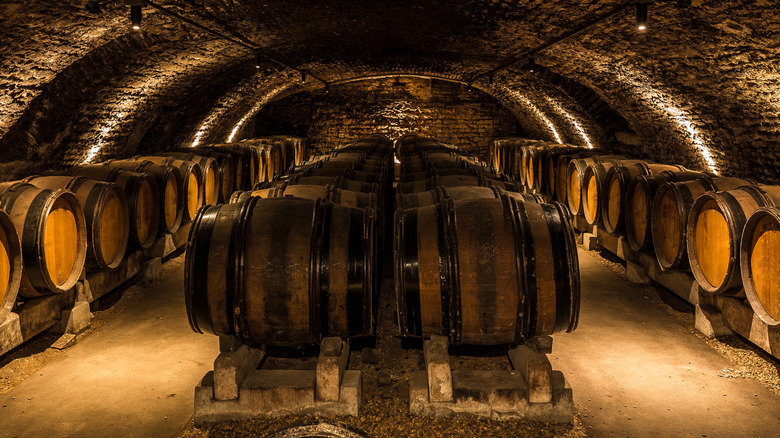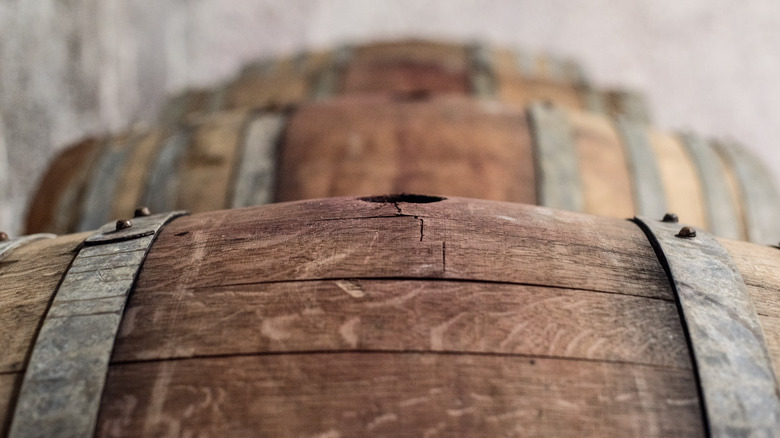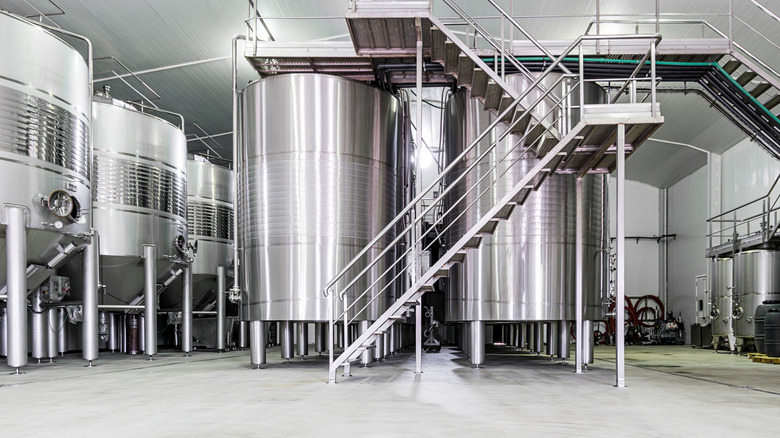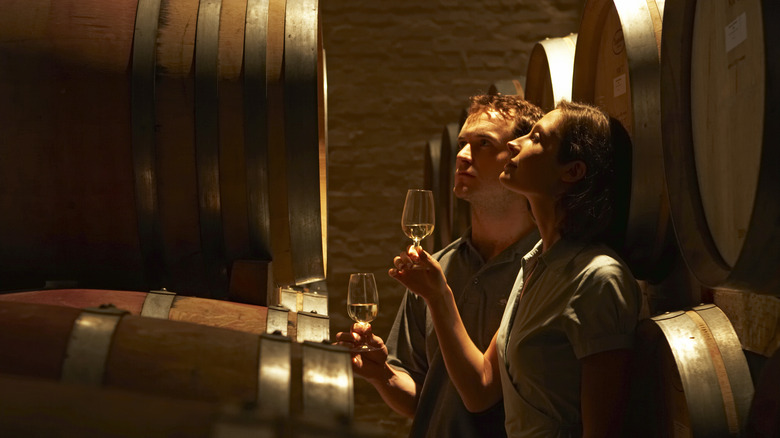How Stainless Steel Vs. Oak Barrel Aging Impacts Wine
Wine, at times a luxury, at others a drink for the common man, has been a part of global history for as long as anyone can remember. It has always been regarded as an important social and cultural beverage, but it has gone through some dramatic evolutions since it was first squeezed from the vine centuries ago. It is strange to imagine, but wine for a long time was not bottled, nor held in the oak barrels which are in high demand today. Before modern innovation, Bordeaux Magazine says that in 6,000 BC people near the Black Sea were storing and aging their wines in large wax-coated earthenware containers. After that time period, the Egyptians took to storing their wine in clay. It wasn't until the Roman era in Europe that winemakers began to store their alcohol in oak barrels, much like we do today.
According to Vinepair, Romans were the initial ones to begin transporting their wine in oak barrels, and in doing so, they discovered that it had a pleasant effect on the stuff. Smoother taste, more complex flavors, not to mention that the longer in the barrel it stayed, the better it seemed to get! Thus, the art of barreling was born. But in the wine world innovation never stops, so today we have quite a few ways to age our wine. Sure, oak barrels are still at the top of the food chain, but the introduction of stainless steel has changed the game.
What is oak barrel aging?
But before we jump headlong into the comparatively new stainless steel barrels and their influence on aging wine, it is important to have a grasp on oak aging. First and foremost we must ask ourselves, what's the point of aging wine? Wine Magazine explains that the goal of aging wine in oak barrels is to make the beverage more palatable. The effect of the wood in direct contact with the wine quite literally changes the smell and taste of the beverage on a fundamental level, one that a majority of wine drinkers find widely appealing. Wood barrels also give the wine a better tannin structure, help to retain its color, and allow wines to develop secondary aromas so that they age better, have a longer shelf life, and become more nuanced (via Bestheim).
There are several different decisions to make when choosing what kinds of barrels to use on your batch of wine. Food & Wine says that there is everything from the wood's country of origin (French, Hungarian, American, etc.) to the age (new and neutral) to the toast (light, medium, medium plus, and heavy) to decide on, and what winemakers choose to use will have wildly different effects on their product.
According to Wine Folly, oak barrels give wine flavors such as notes of vanilla, clove, and smoke while reducing oxidation (smoothing it out), and for white wines, they can even create a buttery, creamy characteristic most commonly noted in wines like Chardonnay.
Stainless steel
In comparison, stainless steel is really new to the wine world. Wine Business reports that oak and concrete barrels or tanks were what were primarily used in the wine world until the 1950s. That was when stainless steel began being utilized in wineries, even though it didn't add anything to the flavor of the wine as the other materials did. These metal containers did help to prevent the loss of wine and were better at controlling how much oxygen the wine was exposed to. Additionally, winemakers could use advanced technology to better manage the temperature of the wine in stainless steel tanks, improving the fermentation process.
According to South Lyndale, the lack of effect the stainless steel storage has on the wine is actually a positive thing, especially for wine varieties that tend to be light and delicate and whose natural flavors are easily overpowered by the influence of oak. The whole point of stainless steel aging is to let the wine itself shine in a completely neutral environment without the addition of any outside flavors that come from the oak.
This quality is what makes stainless steel so popular with white wines today because it highlights natural bright and crisp flavors inherent to the terroir and fruit itself without bogging it down with vanilla, spices, or notes of butteriness that are not inherent characteristics to the wine.
The big differences
Choosing what material to store your wine in is just another step along the way and really depends on the winemaker's personal tastes. The San Diego Beer, Wine, & Spirits Tours claims that the major difference between oak and barrel aging is what we've discussed above; that oak lends additional flavor and tannin structure to the wine whereas stainless steel is a neutral container. The spices and structure bestowed by the oak are often considered positive characteristics, but if a winemaker is looking to create a crisp and sharp-tasting beverage, the oak really isn't the way to go.
On top of that, some winemakers aren't looking to age their wine for a long period of time and expect people to buy their product off the shelves and drink them fairly quickly, which means the long-term structure isn't a priority and the oak's spices might very well be a detriment to the palatability of a young wine.
In addition, Masterclass says that another factor in choosing stainless steel over oak barreling is the cost of aging. Stainless steel is less expensive because it takes less time and the tanks and barrels don't have to be replaced every year. Some winemakers want to use the cheaper stainless steel option while still obtaining some "oaky" flavor so they add bark chips to the juice, but this only lends superficial vanilla and spice notes to the wine and gives the product absolutely no additional structure.



